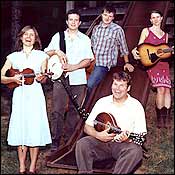
Diminutive, with high and wide cheekbones, blue eyes, and straight, dirty-blonde hair, Heidi Andrade, the fiddler in the young traditional-American-music group Reeltime Travelers, could have stepped out of a cheerful version of a Walker Evans Appalachian photograph. Instead, Andrade dances at the center of a folk, gospel, and bluegrass extravaganza called The Great High Mountain Tour, produced by T Bone Burnett and opening at the Beacon Theatre on May 27. The tour aims to extend the roots-music mission and the ticket-sales success of the 2002 “Down From the Mountain” tour, a road show that developed from the soundtrack of the Coen-brothers movie O Brother, Where Art Thou?
The Reeltime Travelers are just one of ten or so acts—including Alison Krauss & Union Station, Ralph Stanley, and a New York-based soul-gospel group called Ollabelle—who spend almost three hours onstage with nothing but a few mikes, acoustic instruments, and their voices. The groups appear first in individual mini-sets, and then, with Krauss as doyenne, they mix and mingle with one another like recombinant musical DNA. The performance has many original and unexpected numbers, but it makes no apology for coat-tailing on the old-timey music of O Brother and Cold Mountain.
The show comes close to being stolen by the Reeltime Travelers, who had people in Chicago and Milwaukee dancing not only in the aisles but on their seats. And when Andrade stopped her infectious buck-dancing and picked up the fiddle, she half danced with it, too, swaying sensuously. She doesn’t sing much during the vocal numbers, but there she was lifting her voice at the end of the show in the gospel song “Angel Band,” a finale led by Ralph Stanley.
Well, it isn’t quite the finale. There’s an encore in which Stanley lines out the anthemic “Amazing Grace,” allowing the audience and the big cast of performers onstage to sing the song together, highlighting the show’s atmosphere of revival—in both the musical and the religious meanings of the word.
For almost everywhere you listen in this show, you will find the Savior, walking up Calvary, bleeding and dying for you or sitting with the Father, or offering succor to the poor wayfaring stranger or conferring stars in heavenly crowns or being revealed by John the Revelator or dipping his pen of love in your heart. This omnipresence is both stirring and troubling. Stirring, because even for doubters, the Christian faith it generally celebrates is either jubilant and hopeful or offers some comfort to men “of constant sorrow”—a perfect folk-lyric description of clinical depressives—and to proverbial “poor wayfaring strangers” and the whole world of trouble here below. Unsettling, because the kind of intolerant certitude it sometimes represents puts one uncomfortably in mind of the havoc fundamentalism seems to be wreaking everywhere. But this isn’t a reason not to see it—it’s a reason to see it, because it turns what would otherwise be simply a good, old-time-music performance by talented young proselytizers and road-seasoned pros into something sweeter: a hymn with a paradoxical and sad new-timeliness.